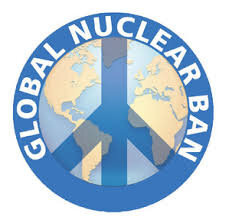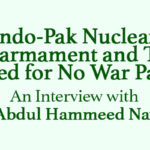Tony Simpson
Bertrand Russell applied quite a stern assessment of the efficacy or otherwise of disarmament treaties. ‘I think we may infer that no disarmament agreement will be reliable unless all signatory States are sincerely convinced that it is to their own advantage, and not only to that of potential enemies.’ So he wrote in Common Sense and Nuclear Warfare, in the context of German rearmament in defiance of the Treaty of Versailles imposed on Germany after the First World War. Common Sense was published in 1959, before international agreements on limiting nuclear testing and use of nuclear weapons had been signed.

So what would Russell make of the Treaty on the Prohibition of Nuclear Weapons? What is in it? What is its importance, bearing in mind its scope and limits?
By resolution 71/258, the UN General Assembly decided to convene in 2017 a United Nations conference to negotiate a legally binding instrument to prohibit nuclear weapons, leading towards their total elimination. The Assembly encouraged all Member States to participate in the Conference, with the participation and contribution of international organisations and civil society representatives. The Conference duly took place from 27 to 31 March and from 15 June to 7 July 2017 in New York, when the Treaty text was finally agreed.
The Treaty runs to 20 articles and includes undertakings not to develop, test, produce, acquire, possess, stockpile, use or threaten to use nuclear weapons. It prohibits deployment of nuclear weapons on national territory, and the provision of assistance to any State in the conduct of prohibited activities.
States parties are obliged to prevent and suppress any activity prohibited under the Treaty undertaken by persons or on territory under its jurisdiction or control.
The Treaty also obliges States parties to provide adequate assistance to individuals affected by the use (specifically mentioning hibakusha – victims of the US nuclear attacks against Hiroshima and then, a few days later, Nagasaki in 1945) or those afflicted by testing of nuclear weapons, as well as to take necessary and appropriate measures of environmental remediation in areas under its jurisdiction or control contaminated as a result of activities related to the testing or use of nuclear weapons.
The Treaty was adopted by the Conference on 7 July 2017, by a vote of 122 States in favour, with one vote against (The Netherlands) and one abstention (Singapore). It was opened for signature by the Secretary-General on 20 September 2017. Following the deposit of the 50th instrument of ratification on 24 October 2020, the Treaty will enter into force on 22 January 2021. That is two days after the new President of the United States is due to be installed.
But what does ‘entry into force’ mean? For the Treaty has divided Member States of the United Nations into two distinct camps. On one side, there are more than 120 States publicly backing the Treaty at the UN. They include more than half the states in Africa, South America and Oceania, all 7 Central American states, one in North America, ten out of 26 Caribbean states, and 21 in Eurasia, somewhat unorthodoxly defined as the land mass extending from Ireland in the West to The Philippines in the East.
Lined up against all these are the nine nuclear-armed States and their supporters. Richard Falk, Princeton Professor of International Law and long-time supporter of Russell Tribunals, puts it this way: ‘… there is a near fatal weakness, or at best, a gaping hole, in this newly cast net of legal prohibition … The enormous fly in this healing ointment arises from the refusal of all nine nuclear weapons states to join the Treaty process even to the legitimating extent of participating in the negotiating conference with the opportunity to express their objections and influence the outcome … Most of the chief allies of these states that are part of the global security network of states relying directly or indirectly on nuclear weaponry also boycotted the entire process. India, Japan, and China were notably absent, and also opposed the prohibition. This posture of undisguised opposition …includes all five permanent members of the UN Security Council and such important international actors as Germany and Japan.’
In response to the new Treaty, the NATO nuclear triangle of France, United Kingdom and United States issued a Joint Statement of denunciation: ‘We do not intend to sign, ratify or ever become party to it,’ they said. ‘Therefore, there will be no change in the legal obligations on our countries with respect to nuclear weapons.’ Remarkably, in October 2018, China and Russia joined these three in a subsequent Joint Statement reaffirming their commitment to a separate and different treaty, the Treaty on the Non-Proliferation of Nuclear Weapons, or ‘NPT’, on the occasion of its 50th anniversary. The Permanent 5 said: “The TPNW fails to address the key issues that must be overcome to achieve lasting global nuclear disarmament. It contradicts, and risks undermining, the NPT … We will not support, sign or ratify this Treaty. The TPNW will not be binding on our countries, and we do not accept any claim that it contributes to the development of customary international law …’
There lies the rub – ‘customary international law’. We’ll come back to that.
Sergio Duarte, President of the Pugwash Conferences on Science and World Affairs, was a young member of Brazil’s UN delegation in the 1960s when the NPT was being drafted. He reflects widespread dissatisfaction with the NPT among many states that do not possess nuclear weapons, although, in his view, ‘the perceived shortcomings of the NPT are not sufficient grounds to justify mass withdrawal’. ‘In all fairness,’ he says, ‘it can be said that the NPT was quite successful in helping to prevent additional states to obtain nuclear weapons. Nothing in it, however, deals with other forms of proliferation, such as the accumulation of nuclear arms, their spread all over the globe in airplanes and submarines, or technological improvements in their range, speed, accuracy and lethal power … Nuclear-weapon states seem to interpret the provisions of the NPT as legitimizing their arsenals by claiming an exclusive right to rely on nuclear weapons for their security for as long as they see fit while denying this to all others forever.
Duarte sees the new treaty as complementing the NPT. ‘The persistent standstill in multilateral bodies devoted to disarmament, the recent erosion of the arms control architecture, and the revival of the nuclear arms race gave rise to a successful multilateral effort to negotiate and adopt the Treaty on the Prohibition of Nuclear Weapons in 2017. Progress in the process of entry into force of this new instrument (TPNW) should reassure, rather than alarm, the possessors of such weapons. None of its provisions contradicts the NPT. Rather, it expressly reinforces the commitments already accepted by the non-nuclear parties, and provides a path for fulfilling the commitments to nuclear disarmament.’ He points out that ‘recent technological advancements in artificial intelligence make overwhelming retaliation and second strike a certainty’.
Richard Falk sees the Prohibition Treaty as a ‘frontal rejection of the geopolitical approach to nuclearism, and its contention that the retention and development of nuclear weapons is a proven necessity given the way international society is organized. Falk develops his ideas about going beyond what he calls ‘nuclearism’ in a recent collection of his Selected Writings edited by Stefan Andersson and Curt Dahlgren, published in 2019 by Cambridge University Press.
We have seen that the nuclear states are sensitive on ‘customary international law’, repudiating any claim that the TPNW ‘contributes to the development of customary international law’. But Falk bases his argument for the applicability of customary international law on ‘nuclear taboo’. ‘To establish a customary legal norm,’ he writes ‘requires a long established pattern of consistent state practice of which the nuclear taboo (against the use of nuclear weapons) might serve as evidence having existed for a period of more than seven decades … In effect, a consistent pattern of practice must be reinforced by the sense that behaviour was done with an accompanying sense of obligation. It could be argued, for example, that the nuclear taboo incorporates a strong widely shared sense that nuclear weapons should never be used …’
So what new does the Prohibition Treaty bring to the table? In Falk’s view, the Prohibition Treaty should be treated as a ‘historic step forward’. It gives authoritative legal backing to the profound populist stigmatization of nuclear weapons, and as such provides anti-nuclear civil society forces with a powerful instrument to alter the climate of opinion in nuclear weapon states.
ICAN, the International Campaign against Nuclear Weapons, already publishes DON’T BANK ON THE BOMB, a regular report highlighting companies and organisations that profit from the production and maintenance of nuclear weapons, and those, such as the Dutch pension fund, which are choosing to divest. ICAN’s spokeswoman, Beatrice Fihn, aims to ‘deligitimize nuclear weapons and devalue them’, as she explains in the current issue of the Bulletin of the Atomic Scientists. With an annual budget of a million Swiss francs, rather more than a million US dollars, ICAN does sterling work to advance and spread the reach of the new Prohibition Treaty, from its base in Geneva. Principal funders include the governments of Austria, Ireland and New Zealand, Swiss local councils, plus some private Foundations and individuals.
So what would Bertie say? He would surely applaud the sustained international activism over a decade or more which has brought the Prohibition Treaty to the point where it is endorsed by two-thirds of the Member States of the United Nations, across all inhabited continents, with new signatories, most recently Niger, continuing to join the ranks. He would probably be more sceptical about the prospects of the Treaty in eliminating nuclear weapons. In particular, he emphasized the need for détente to build confidence in verification measures to ensure genuine disarmament. Writing during the Cold War years, Russell’s insight was borne out following the collapse of the Soviet Union in 1991 when actual nuclear disarmament was carried through by Kazakhstan and Ukraine, with international participation. But confidence and trust are again in short supply, particularly between Russia and the United States, as the principal nuclear-armed states, with China now also figuring more prominently in such ‘gaming’, as Alva Myrdal, the Swedish Disarmament Minister and Nobel Peace Laureate, characterized what was then described as ‘superpower’ conduct in relation to disarmament in the late 1970s. The Prohibition Treaty exposes the sharp divergence of interests of the nuclear ‘haves’ and ‘have-nots’. It’s an old story, but I think Russell would have been encouraged by the renewed and rising awareness of the threat to humanity posed by nuclear weapons, which the Prohibition Treaty, and the explicit opposition to it on the part of the nuclear-armed states, sparks. ‘We appeal as human beings to human beings: Remember your humanity and forget the rest.’
This is the text of Tony Simpson’s talk to the Bertrand Russell Society delivered on 12 December 2020. Tony is the Secretary of the Bertrand Russell Peace Foundation.
Bertrand Russell Society: https://bertrandrussellsociety.org/


